A watery chill cloaks the installation by Glexis Novoa at Lowe Art Museum of the University of Miami. Occupying a single gallery, it's paradoxically filled with the aura of absence and loss.
The title itself says volumes regarding an exhibit emphatically devoid of art objects that can be handled and transported. "Glexis Novoa: Emptiness" deliberately gives viewers little to examine and deceptively little to experience.
.
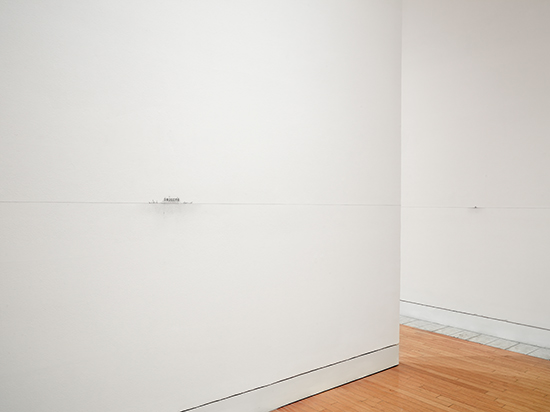
"Emptiness" by Glexis Novoa. Photo: Daniel Portnoy.
.
When the show ends, nothing will remain. As a museum statement explains, "It will close with a public 'effacement' ceremony led by the artist on October 1, 2015."
"Emptiness" contrasts with the Lowe's 2006 exhibit, "Glexis Novoa, Visionary Artist," which featured 13 works, including sculpture, graphite drawings on marble, an installation, and lithographs. It was accompanied by a catalog essay, "Power Trips and Time Travel" by art historian Paula Harper, who discussed Novoa's distinguished career and ties to Miami, as well as his abiding interest in historical monuments and images of political power.
Harper noted that the Cuban-born artist left his country in 1992 when the censorious climate of the island became too constricting for him, moving first to Mexico. Three years later, after gaining political asylum in the United States, he settled in Miami. Significantly, before leaving Cuba, Novoa had belonged to his country's internationally admired "eighties generation" of artists. Their adventurous, experimental work was created by the first generation of artists born after the Cuban Revolution, and Novoa had accompanied fellow artists on game-changing travels to Europe and Russia.
Since 2013 Novoa has maintained studios in both Havana and Miami. His art has been exhibited at museums and art venues in Miami, New York, and Boston, as well as in Havana, Caracas, Barcelona, Madrid, Mexico City, Dublin, Dusseldorf, and other cities. His work belongs to various public and private collections, including those of Lowe Art Museum, Pérez Art Museum Miami, Ludwig Forum Fur International Kunst in Aachen, Germany, and Centro Wifredo Lam in Havana.
'Landscapes in Distress'
For this exhibit, Novoa created what he considers a single drawing, composed of 15 tiny graphite drawings on museum walls. Depicting fragments of what urban planners like to call "the built environment," numerous drawings are of architectural structures. Others ominously suggest eyes of all-seeing cameras. Yet there are no figures, not a soul to be seen among these buildings, another unsettling aspect of the installation's emptiness.
.

"Emptiness" by Glexis Novoa. Photo: Daniel Portnoy.
.
As the artist explained in a phone interview in Miami on July 20, 2015, he has created "a post-apocalyptic version of reality." The 15 individual drawings portray "landscapes in distress."
One especially bizarre architectural cluster brings together Egyptian pyramids, a rectangular structure resembling New York's Seagram Building, and a group of Gothic-style turrets. Other structures include sculpture and scaffolding for signage, enigmatically reading, for instance, “FORMS.” They often seem crowded onto a barely distinct shoreline, with slight shadings of gray evoking surrounding waters. Consider the drawings distant visions of cities perched precariously on land's edge.
.

"Emptiness" by Glexis Novoa. Photo: Daniel Portnoy.
.

"Emptiness" by Glexis Novoa. Photo: Daniel Portnoy.
.
Delicately rendered with fleeting references to recognizable locations, these urban fragments of Novoa's installation are placed on a straight graphite pencil-drawn line encircling the museum's Friends of Art Gallery. This line, resembling the horizon in a landscape, is 5 feet above the floor, so that the drawings can be seen at many visitors' eye level.
Graphite drawings have long been a signature feature of Novoa's art. Such drawings have been executed on various supports, including stretched canvas, walls of private collectors' homes and art venues, and marble slabs. To create their astonishingly miniscule details, Novoa wears jewelers magnifying glasses.
.
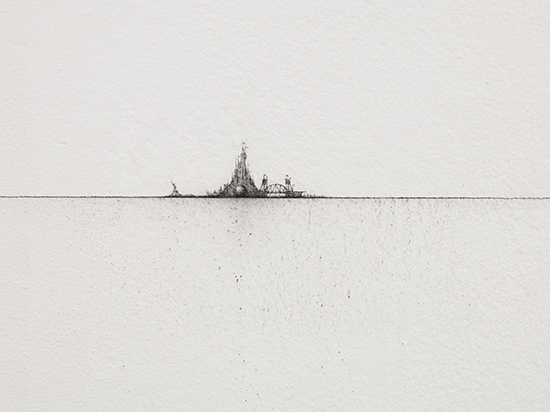
"Emptiness" by Glexis Novoa. Photo: Daniel Portnoy.
.
Deliberately Disorienting
For previous exhibits and installations, Novoa has often created specific works laced with formal rhythms linking tiny drawings with other drawings, also architecturally complex but easier to examine with the naked eye. In "Emptiness," there's no such relief. Possessing as it does a flurry of disjointed architectural references, it's hard not to leave this exhibit without a headache from squinting.
These distant views of cities at land's edge are not only disjointed but disorienting—indeed, frustrating. And that is clearly Novoa's point.
.

"Emptiness" by Glexis Novoa. Photo: Daniel Portnoy.
.
The artist’s remarkable skill at rendering familiar-seeming details raises fundamental questions about what, precisely, we are looking at in this gallery. Individual drawings often present puzzling inconsistencies of time and place—evoking a dream world, a mirage, a land of smoke and mirrors. What is familiar and what is not?
.
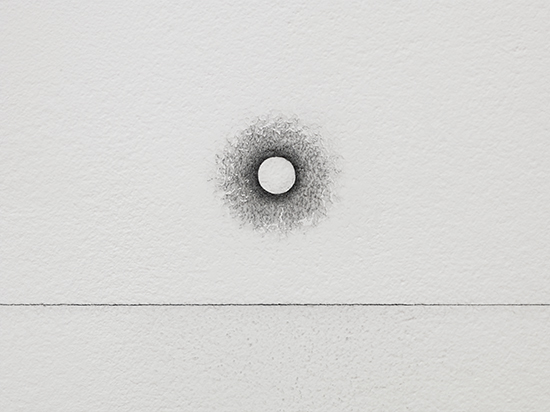
"Emptiness" by Glexis Novoa. Photo: Daniel Portnoy.
.
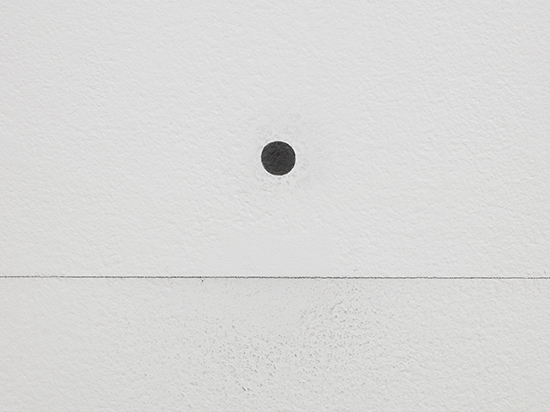
"Emptiness" by Glexis Novoa. Photo: Daniel Portnoy.
.
"Emptiness" provokes additional questions. Consistent with his previous work, Novoa depicts places that seem to be continually watched, with minute antennae dangling overhead from what could be blimps, most likely carrying out state-sponsored surveillance. And yet, in these odd and eerie scenes, there's no one to watch. Is everyone in hiding? Already captured and jailed? Tortured? Killed?
.
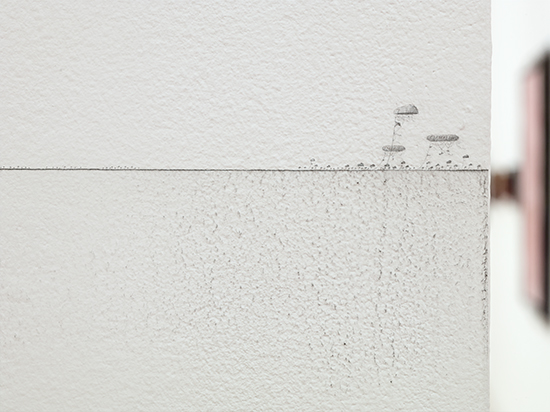
"Emptiness" by Glexis Novoa. Photo: Daniel Portnoy.
.
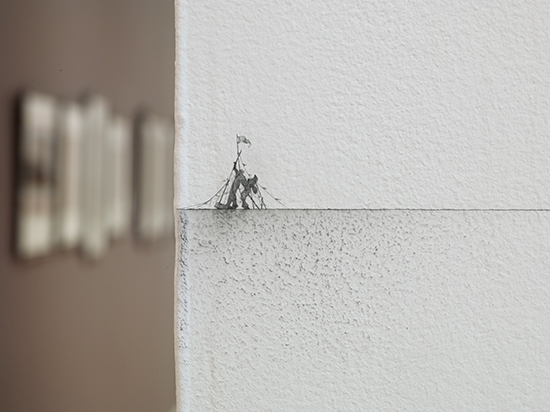
"Emptiness" by Glexis Novoa. Photo: Daniel Portnoy.
.
In our post-911 era of WikiLeaks, National Security Agency domestic and international monitoring of cell phones, and rampant social media, Novoa's beautiful drawings seem appallingly in synch with the times, in which boundaries between public and private realms erode more every day.
Anti-object Art Exhibit
Nova's decision to create an ephemeral, object-less art exhibit on museum walls also speaks to the current overheated art market.
In every respect, "Emptiness" is an anti-object art exhibit. It defiantly counters the trend by some collectors to treat artworks as speculative real estate properties, which can be "flipped" or sold quickly to make a fast buck.
.
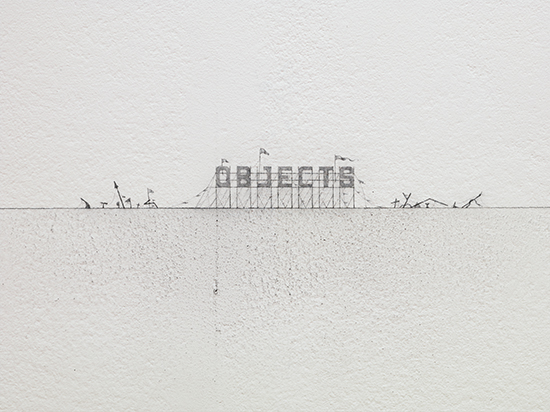
"Emptiness" by Glexis Novoa. Photo: Daniel Portnoy.
.
"I'm not against the art market," Novoa confessed patiently. "But this is nonsense. It's like an obsession with objects. When you are obsessed, you become blind. Collectors want more and more objects. They don't think about what the art is telling them." He's concerned that this accelerated, object-driven concept of art contributes to a frightening myopia regarding the significance of history.
In a vivid example of the artist's fascination with historically rich objects and structures, one drawing recalls the over 6-foot-tall version of Brancusi's Endless Column in the collection of the Museum of Modern Art. Like many structures in these drawings, this classic Modernist icon is draped with innumerable strings as if it is off-limits and must be secured in place. Is it somehow dangerous? Is it structurally unsound and about to collapse? And who wants to keep us from approaching it?
.
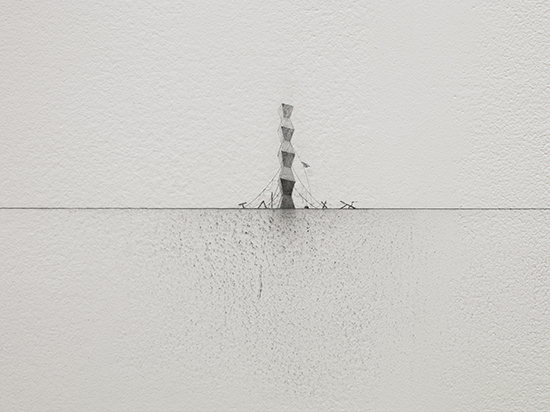
"Emptiness" by Glexis Novoa. Photo: Daniel Portnoy.
.
Presenting fantastical cityscapes on that 5-foot-high horizon line wrapped around the museum gallery, he replicates the perspective of someone in the ocean several miles from a coastal city, with buildings appearing to rise up directly from the juncture of land and water. This person could be on a perilous journey, either swimming or on a small boat miles from land. A cityscape for that person is tantalizingly visible but perhaps impossible to reach.
.
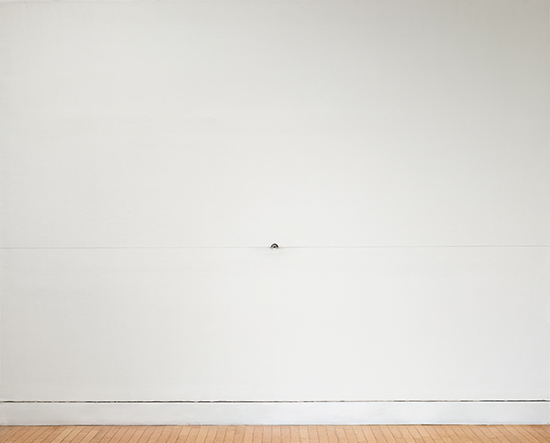
"Emptiness" by Glexis Novoa. Photo: Daniel Portnoy.
.
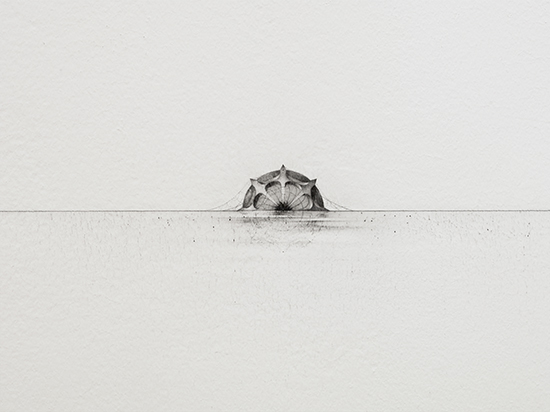
"Emptiness" by Glexis Novoa. Photo: Daniel Portnoy.
.
Evoking the eye-level perspective of an anxious traveler looking at these distant cities, Novoa has created a disturbing, even maddening installation. It's informed by years he has spent in both Havana and Miami. Both cities are famed for views of their coastline—from the perspective of tourists, yes, but also from so-called "boat people" desperately attempting to arrive or depart.
.
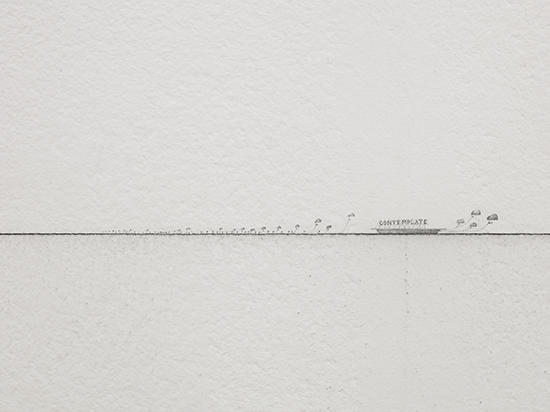
"Emptiness" by Glexis Novoa. Photo: Daniel Portnoy.
.

"Emptiness" by Glexis Novoa. Photo: Daniel Portnoy.
.
Historic Change in Miami and Havana
Once again, this low-key and tough-to-view installation is slyly in synch with a historic moment—one for both Havana and Miami, home to many thousands of Cuban exiles and Cuban Americans since Fidel Castro came to power in Cuba in 1959.
Now that Cuba and the United States are resuming diplomatic relations after more than five decades of estrangement, Novoa says he's becoming more comfortable travelling back and forth between the cities he knows so well. Although it's not at all clear how much this historic shift reflects any changes in Cuba's repressive government, Novoa says that the opportunity to work in both cities is already changing his art.
When he left Cuba, he recalled, he stopped painting. Now he's reconnecting with that part of his career, perhaps because he finds it easier to concentrate in his homeland than in Miami. "Here it's very agitated. We have Facebook," he said. "I draw in Miami. I paint in Havana."
Surely "Emptiness" foretells another game-changing period, not to mention exhibit, for this prolific artist.
__________________________
BASIC FACTS: "Glexis Novoa: Emptiness" through October 1, 2015 at Lowe Art Museum, University of Miami, 1301 Stanford Drive, Coral Gables, Florida 33124. www.lowemuseum.org.
__________________________
Copyright 2015 Hamptons Art Hub LLC. All rights reserved.

A must see.